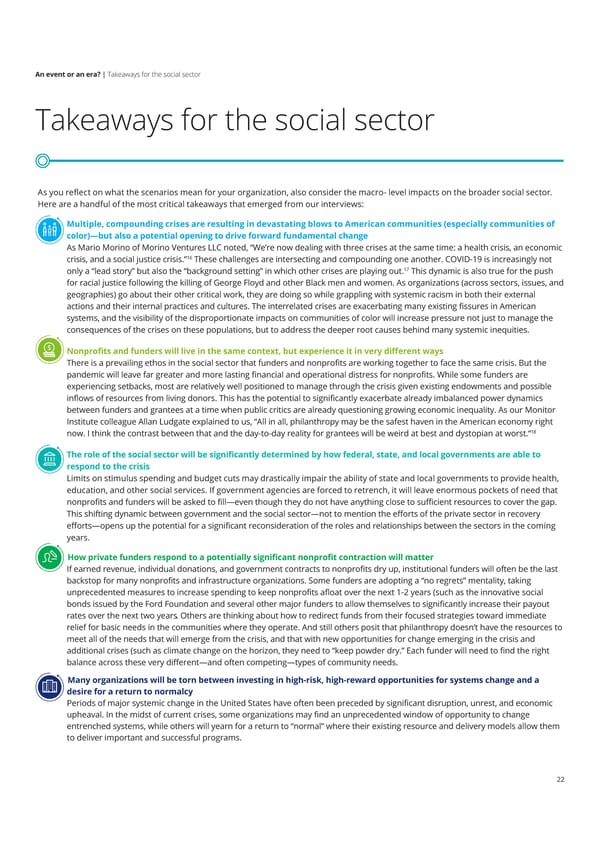An event or an era? | Takeaways for the social sector Takeaways for the social sector As you reflect on what the scenarios mean for your organization, also consider the macro- level impacts on the broader social sector. Here are a handful of the most critical takeaways that emerged from our interviews: Multiple, compounding crises are resulting in devastating blows to American communities (especially communities of color)—but also a potential opening to drive forward fundamental change As Mario Morino of Morino Ventures LLC noted, “We’re now dealing with three crises at the same time: a health crisis, an economic 16 crisis, and a social justice crisis.” These challenges are intersecting and compounding one another. COVID-19 is increasingly not 17 only a “lead story” but also the “background setting” in which other crises are playing out. This dynamic is also true for the push for racial justice following the killing of George Floyd and other Black men and women. As organizations (across sectors, issues, and geographies) go about their other critical work, they are doing so while grappling with systemic racism in both their external actions and their internal practices and cultures. The interrelated crises are exacerbating many existing fissures in American systems, and the visibility of the disproportionate impacts on communities of color will increase pressure not just to manage the consequences of the crises on these populations, but to address the deeper root causes behind many systemic inequities. Nonprofits and funders will live in the same context, but experience it in very different ways There is a prevailing ethos in the social sector that funders and nonprofits are working together to face the same crisis. But the pandemic will leave far greater and more lasting financial and operational distress for nonprofits. While some funders are experiencing setbacks, most are relatively well positioned to manage through the crisis given existing endowments and possible inflows of resources from living donors. This has the potential to significantly exacerbate already imbalanced power dynamics between funders and grantees at a time when public critics are already questioning growing economic inequality. As our Monitor Institute colleague Allan Ludgate explained to us, “All in all, philanthropy may be the safest haven in the American economy right 18 now. I think the contrast between that and the day-to-day reality for grantees will be weird at best and dystopian at worst.“ The role of the social sector will be significantly determined by how federal, state, and local governments are able to respond to the crisis Limits on stimulus spending and budget cuts may drastically impair the ability of state and local governments to provide health, education, and other social services. If government agencies are forced to retrench, it will leave enormous pockets of need that nonprofits and funders will be asked to fill—even though they do not have anything close to sufficient resources to cover the gap. This shifting dynamic between government and the social sector—not to mention the efforts of the private sector in recovery efforts—opens up the potential for a significant reconsideration of the roles and relationships between the sectors in the coming years. How private funders respond to a potentially significant nonprofit contraction will matter If earned revenue, individual donations, and government contracts to nonprofits dry up, institutional funders will often be the last backstop for many nonprofits and infrastructure organizations. Some funders are adopting a “no regrets” mentality, taking unprecedented measures to increase spending to keep nonprofits afloat over the next 1-2 years (such as the innovative social bonds issued by the Ford Foundation and several other major funders to allow themselves to significantly increase their payout rates over the next two years. Others are thinking about how to redirect funds from their focused strategies toward immediate relief for basic needs in the communities where they operate. And still others posit that philanthropy doesn’t have the resources to meet all of the needs that will emerge from the crisis, and that with new opportunities for change emerging in the crisis and additional crises (such as climate change on the horizon, they need to “keep powder dry.” Each funder will need to find the right balance across these very different—and often competing—types of community needs. Many organizations will be torn between investing in high-risk, high-reward opportunities for systems change and a desire for a return to normalcy Periods of major systemic change in the United States have often been preceded by significant disruption, unrest, and economic upheaval. In the midst of current crises, some organizations may find an unprecedented window of opportunity to change entrenched systems, while others will yearn for a return to “normal” where their existing resource and delivery models allow them to deliver important and successful programs. 22
 US Deloitte Monitor Institute Page 21 Page 23
US Deloitte Monitor Institute Page 21 Page 23